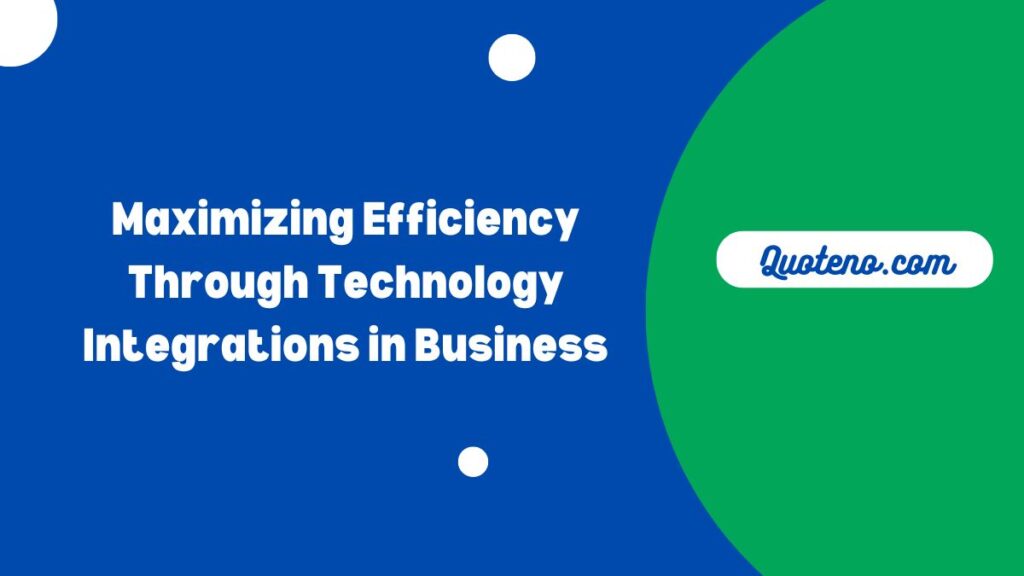Key Takeaways:
- Integrating technology bolsters business efficiency and adaptability in a rapidly evolving market.
- Diverse technology platforms like SaaS, CRM, and ERP play critical roles in operational streamlining.
- Adoption challenges can be addressed through strategic planning and employee engagement.
- Data security remains paramount during technological transformation.
Table of Contents
Technology Integration in Business Operations
The contemporary business environment is a testament to the power of digital transformation. Organizations that harness the potential of technology integrations, such as effective bookkeeping packages, position themselves at the forefront of efficiency and innovation.
These integrations go beyond simple software additions; they represent a reimagining of company workflows and customer interactions while empowering businesses to thrive in an increasingly digital economy. Embracing these changes can improve operational efficiency and enhance customer satisfaction and competitive advantage.
The Evolution of Business Technology Tools
Looking back, yesteryear’s cumbersome ledgers and manual processes were ripe for innovation. Today’s business technology has evolved into sophisticated tools that automate and refine operations. The transition from paper to digital was just the beginning; we’ve witnessed the emergence of industry-specific software, cloud-based solutions, and AI-driven analytics that have fundamentally altered how business is conducted.
The sweeping influence of these tools speaks to a larger narrative of progress, one where businesses not only react to technological changes but also anticipate and leverage them for strategic growth. This evolution is part of a larger digital wave that has touched every industry, compelling businesses to adapt or risk obsolescence.
Identifying Business Needs for Technology Integration
In the age of endless software options and technological solutions, it’s crucial to discern precisely what your business requires to boost productivity and efficiency. This process begins with thoroughly assessing existing operational procedures and discerning the bottlenecks and areas where automation could yield significant benefits.
The goal is to pinpoint where technology can simplify tasks, enabling the workforce to focus on more strategic initiatives. Once you grasp your enterprise’s needs, you can explore various technology integrations, ensuring they align with your overarching business goals and seamlessly integrate into your existing processes.
Exploring Types of Business Technology Integrations
The landscape of technology solutions is vast, with a solution for virtually every challenge a business might face. At the forefront of these integrations are Software-as-a-Service (SaaS) platforms that offer scalability and accessibility, Customer Relationship Management (CRM) systems that provide invaluable insights into customer behavior, and expansive Enterprise Resource Planning (ERP) tools that unify numerous business functions into a single, streamlined ecosystem.
Grasping the potential of each type of integration allows for a strategic approach to technology adoption, ensuring that investments will yield palpable improvements in process efficiency and data management.
The Role of Cloud Computing in Technology Integration
The advent of cloud computing has marked a sea change in the feasibility and scalability of technology integrations. By embracing cloud services, businesses can access a flexible, cost-effective infrastructure that supports growth and facilitates collaboration across teams and geographies.
Moreover, cloud-based platforms often have the added benefit of regular, seamless updates, ensuring that the business always operates with the latest advancements without incurring disruptive downtime or costly upgrades. This balance of agility and cost efficiency has made cloud computing a cornerstone of modern business operations.
Importance of Data Security in Technology Integrations
As business operations migrate to digital platforms, the importance of robust data security protocols cannot be overstated. The threat landscape is constantly evolving, and so must an organization’s defenses against potential breaches.
Firms are tasked with safeguarding sensitive information and maintaining compliance with a complex web of international and regional data protection laws. A diligent approach to cybersecurity, including regular audits and employee training, is critical to preserving customer trust and avoiding costly legal penalties.
Measuring the Success of Technology Integrations
To effectively measure the impact of technology integrations, businesses must set quantifiable objectives before adoption. By identifying key performance indicators (KPIs) and regularly reviewing relevant metrics, companies can make data-driven decisions that refine operations further.
This ongoing evaluation process allows for strategically adjusting technology tools, ensuring the business is continuously optimized for superior performance. Moreover, real-life case studies of successful technology integrations may serve as models, providing insights into best practices and highlighting potential pitfalls to avoid. Understanding the dynamics of successful technology adoption is essential to replicating these outcomes.
Future Outlook: Technology Integration and Innovation
The trajectory of technology integration in business points to a landscape of continuous innovation. As emerging technologies like artificial intelligence, blockchain, and the Internet of Things become more sophisticated and accessible, they have the potential to redefine how businesses operate.
Keeping pace with these advancements is not merely a matter of staying current—it’s a competitive imperative. Businesses that anticipate and embrace these changes are the ones that will flourish in the dynamic, tech-driven marketplace of tomorrow.
Conclusion: Leveraging Technology for a Competitive Edge
Integrating technology into business operations is an essential endeavor that yields significant dividends in efficiency and strategic advantage. While the path of digital transformation presents its share of challenges, pursuing technological integration is indispensable in an era where digital prowess equates to market leadership.
Businesses must stay alert to the potential of emerging technologies, ensuring that their operations remain agile and responsive to the demands of a digital-first economy. By doing so, they secure not just their present success but also their future relevance.
- 5 Must-Visit Travel Destinations to Enrich Your Knowledge of History and Culture - May 17, 2024
- 5 Services Your Small Business Needs ASAP - May 13, 2024
- Maintaining Home Integrity: The Unseen Value of Gutters - May 13, 2024

